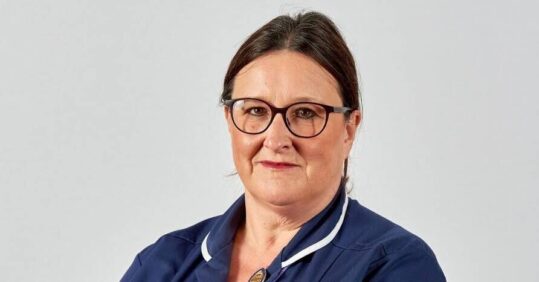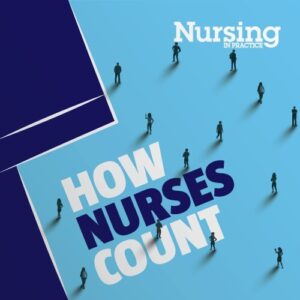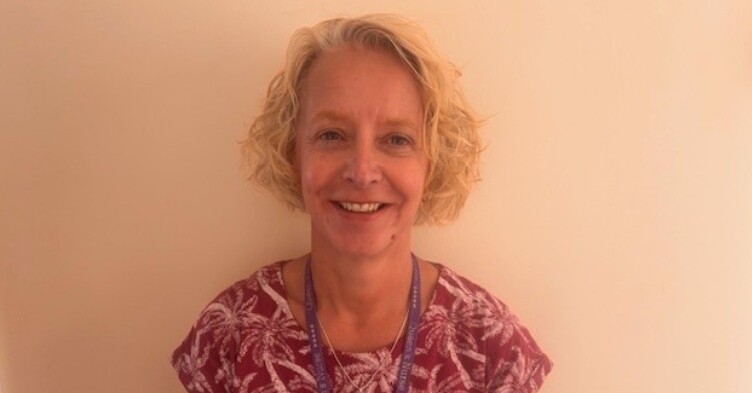Interview: New QICN chief on priorities, challenges and the 10-year plan

In her first exclusive interview with Nursing in Practice, new Queen’s Institute of Community Nursing (QICN) chief executive Steph Lawrence sits down with Megan Ford to discuss her priorities for the organisation, the unique challenges for practice nurses and why she supports our newly launched campaign.
As the new leader of the QICN, Steph Lawrence says it is her vision for the charity to become the ‘go-to’ organisation on all things community nursing – including primary care – among the government, NHS England and other key stakeholders.
Importantly, she sees the QICN, with the development of its new faculties and networks, as ‘a home’ for primary care and community nurses where they feel supported and enabled to discuss the ‘knotty issues’ they face.
Ms Lawrence replaced Dr Crystal Oldman at the start of July, having formerly been the QICN’s deputy chief executive and director of nursing since October 2024. A currently practising district nurse and Queen’s Nurse, Ms Lawrence has been registered for more than 37 years, with the last 22 years spent working in the community, including as an advanced nurse practitioner in primary care.
The challenges for GPNs
It is Ms Lawrence’s concern that practice nurses can be ‘an invisible part of the primary care workforce at times’.
With pay, terms and conditions of GPNs being at the discretion of each GP practice and without a national ‘consensus’ on what this should look like, Ms Lawrence recognises the significant challenge brought to the profession and the damaging effect on recruitment and retention.
She supported calls for practice nurses and their employment conditions to be ‘formally mentioned’ in the GP contract – suggesting the move was ‘critical’.
Last month, the government told Nursing in Practice that a new substantive GP contract in England – due by 2028 – ‘could address’ practice nurse terms and conditions. The Department of Health and Social Care’s comment came in response to concerns raised on social media by England’s primary care nursing lead, Louise Brady, who urged the government to ensure practice nurses are given an annual pay rise and above statutory maternity, paternity and sick pay.
More widely, further concerns have been raised that a lack of good maternity or sick pay is deterring young nurses from joining general practice. An exclusive Nursing in Practice survey this year suggested that only 5% of GP nursing staff receive above statutory maternity pay, while around a third (32%) received occupational sick pay above statutory levels.
Ms Lawrence says she recognises that recruitment and retention within practice nursing is a challenge because of these issues.
‘If you’re not going to get a full maternity leave, or you’re not going to get good period of sick pay, those types of things, that is an issue for people. And I understand that,’ she says.
Related Article: What we know so far about the government’s nurse ‘Graduate Guarantee’
Another challenge was the introduction of the Additional Roles Reimbursement Scheme – used by primary care networks (PCNs) to employ staff to work across general practice – in 2019. GPNs had been excluded the scheme until this year, while nursing associates and ANPs had been covered.
‘I think there’s an assumption sometimes that another, different professional can do the role of a nurse,’ says Ms Lawrence.
‘I would obviously argue that that is not the case. You can’t replace a nurse with a non-nurse. If you want nursing, then you have to have a nurse.’
The new chief executive pointed to the QICN’s recently launched Faculty of General Practice Nursing and General Practice Nurse Network. The faculty hopes to be a ‘key reference point’ for the profession, with resources, information, a dedicated website page and a programme of webinars and events for GPNs available. Meanwhile, the network aims to provide GPNs a space to network and share best practice, as well as to discuss innovations and the value of the workforce.
Ms Lawrence says the faculty is seen as an ‘area where we can use that to support general practice nurses’.
‘[While] we don’t get involved in the political side of pay and conditions, we absolutely will stand with our practice nurse colleagues and look at all the things that we can do as an organisation to support. Can we provide evidence? Can we provide nurses that can speak truth to power from where they’re sat?’
In July, the QICN launched a second faculty aimed at adult social care nurses. ‘Again, issues around pay and conditions for people working in and across different organisations is a real issue,’ says Ms Lawrence.
‘So, I see the QICN’s role with the development of the faculties, and there’s more to come, as a place, a home for those people.’
‘I see us as having that supportive role and looking at how we can support nurses from all sectors in community. As the faculties develop, that’ll be a real place we can do that.’
How Nurses Count
Nursing in Practice last month launched its How Nurses Count campaign – aiming to champion the work of practice nurses and shine a light on all the ways in which they make a difference.
 The How Nurses Count campaign is seeking out good examples of the impact of nurses in general practice, whether that is in patient consultations, clinics, team meetings, as clinicians, leaders, advocates for patients, prescribers, problem-solvers, and more. The hope is to evidence the contribution of GPNs to the government and key health leaders to ensure the profession is better recognised and valued.
The How Nurses Count campaign is seeking out good examples of the impact of nurses in general practice, whether that is in patient consultations, clinics, team meetings, as clinicians, leaders, advocates for patients, prescribers, problem-solvers, and more. The hope is to evidence the contribution of GPNs to the government and key health leaders to ensure the profession is better recognised and valued.
Ms Lawrence was asked for her thoughts on the campaign.
‘I think this is really, really crucial,’ she says.
‘I think practice nurses are an invisible part of the primary care workforce at times.
‘I think that need to be in the GP contract is critical. I think they have to be formally mentioned. Because I think if you look at the stats, the majority of work done in primary care is probably done – as well as by GPs – by primary care nurses.’
She adds: ‘I think the other thing I’d want to say is, please don’t try and replace them with a different profession. Nursing associates are not registered nurses and they are not general practice nurses. Equally, advanced practitioners are not general practice nurses.
‘I’m speaking as an advanced practitioner who did work in primary care, I’m really clear that I’m not a general practice nurse. I could do the advanced practice side of things, but I wasn’t an expert in all the long-term conditions and the prevention and the immunisation, vaccination.
Related Article: We must celebrate what’s good about nursing in general practice
‘The variety and breadth of the role of a general practice nurse is huge and I think we lose sight of this.
‘So, anything we can do to promote that and make sure it’s heard and seen at a government level – we will support you and our general practice nurses out there in any way that we can.’
The NHS 10-year plan
Ms Lawrence took up the post of chief executive just days before the release of the highly anticipated 10-year plan for the NHS – which focuses on the government’s three shifts: from hospital to community; analogue to digital; and sickness to prevention.
She says she welcomes the plan and that its shifts ‘are absolutely the right shifts’, but that investment into the community nursing workforce was vital in order for the plan to succeed.
Citing latest data from the Nuffield Trust, she warns how the number of district nurses working in the NHS in England has fallen by 43% between 2009 and 2024.
‘We cannot deliver a 10-year plan that talks about a shift of care into the community without district nurses,’ says Ms Lawrence.
And she echoed the thoughts of her predecessor Dr Oldman, and warned the government against developing ‘bright, shiny new services in the community’.
‘We’ve got amazing community services in this country. We need to build on them,’ she adds.
The government’s plan for the health service centres on the move towards a ‘neighbourhood health service’ and sets out how nurses, alongside health visitors, palliative care staff, doctors and others, will staff new ‘neighbourhood health centres’.
But Ms Lawrence says the focus should be on building community and primary care nursing teams ‘as they stand right now’, rather than introducing something new or a new neighbourhood team nurse role, for example.
‘Let’s work with those nurses out there, because they know what works,’ she adds.
A vision for the QICN
When asked of her priorities for the QICN, Ms Lawrence says she wants to build on the work of Dr Oldman – who had been at the helm for 13 years – and become the ‘go-to’ organisation when it comes to community nursing.
Related Article: Lower limb care in general practice: ‘It’s about giving people their lives back’
‘We’ve got huge networks of Queen’s nurses, plus other specialist networks and we can get people to the table who have the expertise that’s needed,’ she says.
‘So, I want, the government, I want [health secretary] Wes Streeting, I want NHS England, whoever it might be – if there’s something that they need to know about community nursing, then we’re the organisation that they come to.
‘I know under Crystal that has happened, [and] I’d like to build on that even more and make sure that we are that go to place.’
It is also important that the QICN is a ‘solution-focused’ organisation and one that works in collaboration with others where appropriate, including other nursing charities, the national chief nursing officer or the Royal College of Nursing.
‘Whoever it might be, I think we’re here to try and support that and to bring that voice and that knowledge of community nursing,’ she says.

See how our symptom tool can help you make better sense of patient presentations
Click here to search a symptom





![Menopause: identification and management [NG23]](https://s3-eu-west-2.amazonaws.com/images.nursinginpractice.com/wp-media-folder-nursing-in-practice/wp-content/uploads/2025/03/PULSE-NIP-UPLOAD-BAYER-NICE-MENOPAUSE-A5-HANDBOOK.jpg)
